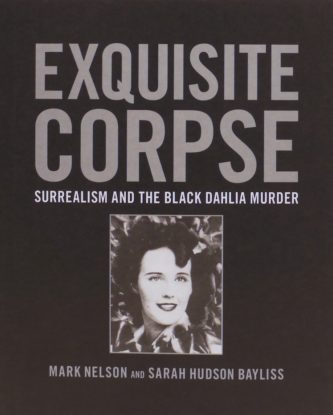 By MARK NELSON, SARAH HUDSON BAYLISS (Bulfinch Press; 2006)
By MARK NELSON, SARAH HUDSON BAYLISS (Bulfinch Press; 2006)
The so-called Black Dahlia murder of 1947, in which the hollowed-out cadaver of aspiring actress Elizabeth Short was found one morning in a Los Angeles lot, continues to inspire all manner of speculation. EXQUISITE CORPSE, a profusely illustrated coffee table hardcover, is the latest in a long line of lengthy analyses on the still-unsolved crime, and one of the most unique.
The book’s emphasis is on the surrealist art movement that began in 1920s Paris. Surrealism emphasized dreams and the unconscious, with practitioners that included Andre Breton, Salvador Dali, Max Ernst and Luis Bunuel. The argument posed by authors Mark Nelson and Sarah Hudson Bayliss is simple: that the bizarre circumstances of Elizabeth Short’s murder were very likely inspired by surrealist principles.
The authors’ starting point was the 2003 bestseller BLACK DAHLIA AVENGER by Steve Hodel, who claims his father, the late physician George Hodel, was the killer. I’ve read that book, and while I’m not entirely convinced by Steve Hodel’s assertions, I feel BLACK DAHLIA AVENGER offers the most convincing assertion of the identity of the Black Dahlia killer that I’ve encountered (it’s the only such book that offers any concrete evidence).
Nelson and Bayliss seem to concur that BLACK DAHLIA AVENGER is the most authoritative Black Dahlia account, as it’s the basis of their findings—specifically the revelation that George Hodel was pals with the surrealist photographer Man Ray. It was this morsel that spurred Nelson, a prominent designer, to begin work on this book, which traces Hodel’s connection to several prominent surrealists, including Marcel Duchamp, Max Ernst and Salvador Dali, as well as like-minded non-surrealists such as Ben Hecht, John Huston and Henry Miller.
The authors provide a brief history of surrealism, reminding us that the movement started out as a violent and antisocial coalition far removed from the whimsical, family-friendly arena where it ended up. Nelson and Bayliss include reproductions of dozens of surrealist paintings and sculptures depicting women bisected and dismembered in various ways, many of them directly replicating the markings on and positioning of Elizabeth Short’s body.
The centerpiece of Nelson and Bayliss’s argument is their analysis of the Marcel Duchamp photographic installation “Etant Donnes,” exhibited following Duchamp’s 1968 death, and picturing a sculpted nude woman whose body position is suspiciously similar to that of Ms. Short. The authors’ implication is that Duchamp, who was acquainted with George Hodel, intentionally referenced the Black Dahlia murder in “Etant Donnes,” and may have had inside information on the crime.
Another possibility the authors bring up is that the murder was committed by multiple individuals practicing the surrealist game of Exquisite Corpse, referring to artists utilizing free association to add on to writing or artwork begun by others. In the case of the Black Dahlia, the game may have been carried out on a living person.
All of this is fascinating, but keep in mind that to fully “get” this book you’ll need at least a passing familiarity with the abovementioned Steve Hodel tome, and also an abiding interest in surrealism. Luckily I meet both criteria, and so found EXQUISITE CORPSE entertaining, enlightening and not a little chilling.
